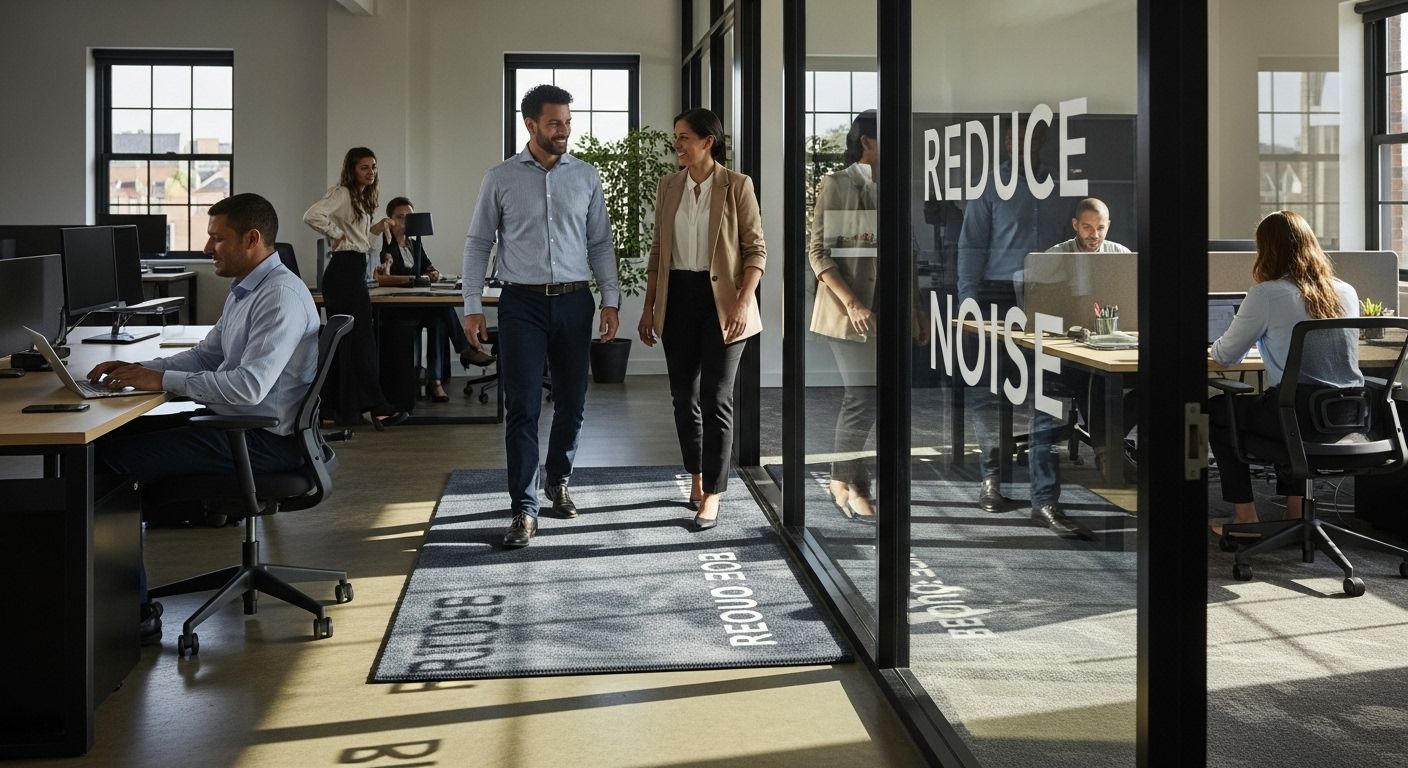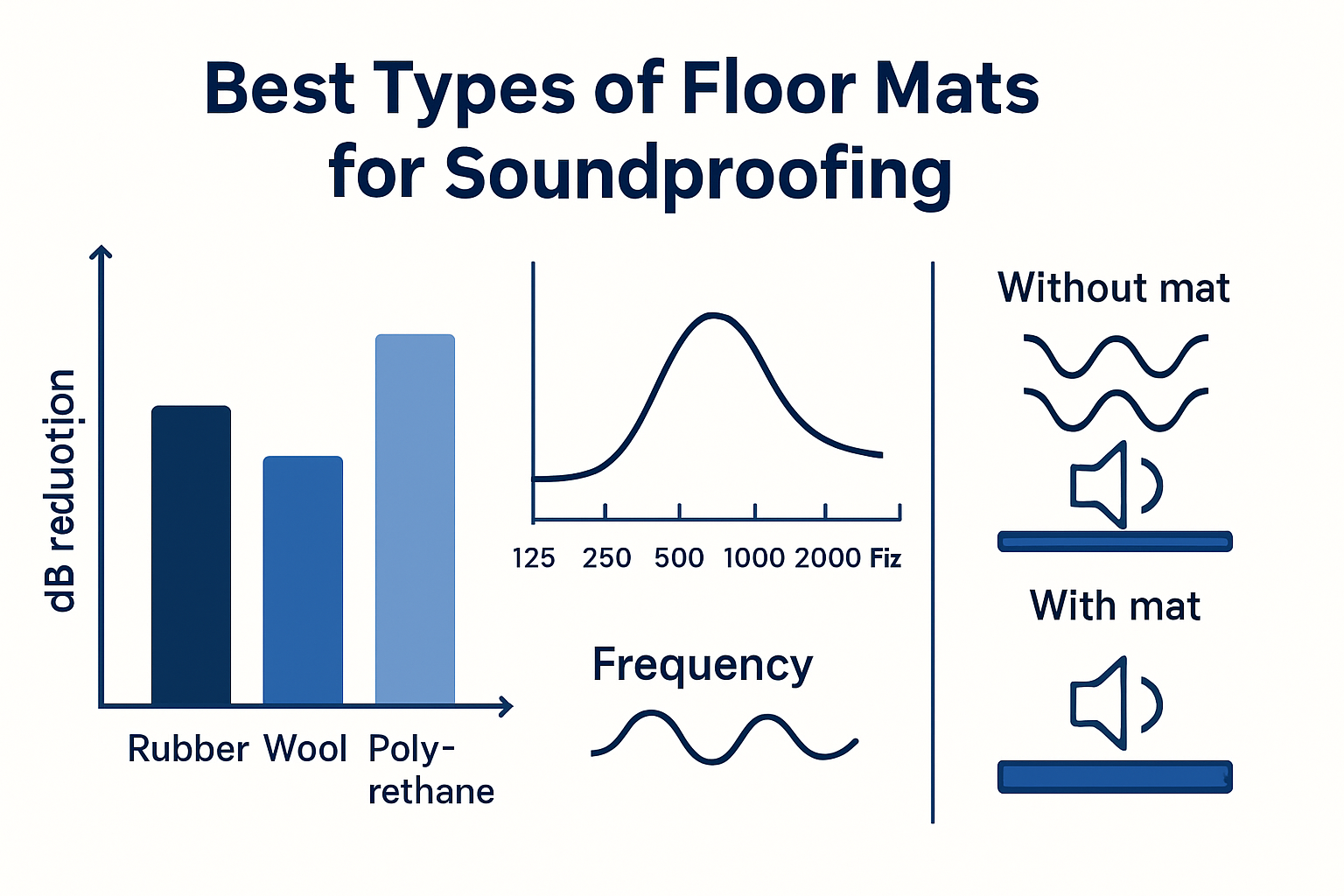
Office noise can make even the simplest tasks feel impossible. Some studies show that excessive background noise decreases productivity and raises stress, especially in busy spaces. Yet, installing the right floor mats can reduce noise by over 90 percent at certain frequencies, delivering benefits most people overlook. These mats do far more than protect your floors. They could be the smartest move for creating a calmer, healthier workplace.
Table of Contents
- How Floor Mats Help Reduce Noise
- Best Types of Floor Mats For Soundproofing
- Benefits Of Noise Reduction For Facilities And Businesses
- Practical Tips For Choosing Noise-Reducing Floor Mats
Quick Summary
| Takeaway | Explanation |
|---|---|
| Floor mats absorb impact noise effectively | Floor mats reduce sound transmission by absorbing acoustic vibrations from footsteps on hard surfaces. |
| Material density directly affects sound reduction | Choosing mats with higher density and thickness enhances sound absorption capabilities significantly. |
| Strategic placement improves acoustic performance | Positioning floor mats in high-traffic areas maximizes their noise reduction impact in sensitive environments. |
| Noise reduction boosts employee productivity | Reducing excessive noise levels improves focus, reduces stress, and enhances overall work efficiency. |
| Health risks are mitigated by noise management | Lowering noise exposure can decrease stress and prevent potential long-term health issues. |
How Floor Mats Help Reduce Noise
Business environments are constantly battling noise challenges that can impact productivity, communication, and overall workplace comfort. Floor mats emerge as a surprisingly effective solution for noise reduction, offering more than just protection for floor surfaces.
Sound Absorption Mechanisms
Floor mats work through critical sound absorption mechanisms that interrupt and minimize noise transmission. When someone walks across a hard surface like concrete or tile, each step creates impact noise that reverberates through the space. Floor mats interrupt this sound transmission by absorbing and dampening acoustic vibrations.
Research from the University of North Dakota demonstrated that floor coverings can significantly reduce noise emissions, particularly in industrial settings. The study found that carpet and mat installations helped stabilize noise levels and decrease sound fluctuations across different frequency ranges. This acoustic buffering is especially critical in environments with high foot traffic or machinery.
Impact Noise Reduction Strategies
Different mat materials offer varying levels of noise reduction. Rubber mats, for instance, provide excellent sound dampening due to their dense molecular structure. Carpet-style mats with thicker pile heights can absorb more sound waves, creating a quieter environment.
According to The Journal of the Acoustical Society of America, floor mats can significantly reduce light-weight impact sounds to near-ambient background noise levels. The effectiveness depends on multiple factors including mat thickness, material density, and underlying floor structure.
Strategic Noise Management
Businesses can strategically deploy floor mats in noise-sensitive areas to optimize acoustic performance. High-traffic zones like hallways, entryways, and work areas benefit most from noise-reducing mat installations. The Carpet and Rug Institute emphasizes that sound-absorbing floor surfaces can create environments more conducive to concentration and communication.
By understanding and implementing targeted noise reduction strategies through floor mat selection, businesses can create more comfortable, productive workspaces. The right floor mats not only protect surfaces but also contribute to a more controlled acoustic environment, supporting employee well-being and operational efficiency.
Best Types of Floor Mats for Soundproofing
Selecting the right floor mat for soundproofing requires understanding the unique acoustic properties of different materials. Not all floor mats are created equal when it comes to noise reduction, and businesses must consider specific characteristics to achieve optimal sound absorption.
To help businesses select the right floor mats for soundproofing, here’s a comparison of different mat materials and their noise reduction properties based on the article:
| Mat Material | Sound Absorption | Best Use Case |
|---|---|---|
| Rubber | Excellent (dense structure) | Industrial environments |
| Carpet-style (thick pile) | High (absorbs more sound waves) | Offices, entryways |
| Wool-based | Very high (>90% at frequencies) | Spaces needing acoustic comfort |
| Polyurethane | High (when dense) | Areas with vibroacoustic needs |
Specialized Acoustic Materials
Certain materials demonstrate exceptional soundproofing capabilities. Research from the National Center for Biotechnology Information revealed that wool-based mats can achieve remarkable sound absorption coefficients, absorbing over 90% of acoustic wave energy at specific frequencies. Wool mats with 25% and 50% wool content showed particularly impressive sound dampening performance.
Polyurethane mats also emerge as a strong contender for soundproofing. A study in the journal Polymers examined vibroacoustic parameters and found that mats with carefully selected densities can significantly improve acoustic comfort. The dynamic stiffness and damping coefficients of these mats play a crucial role in reducing noise transmission.
Performance Considerations for Different Environments
Not all soundproofing solutions work identically across different settings. The Journal of the Acoustical Society of America highlighted that floor mat effectiveness varies depending on impact type and floor structure. Light-weight impact sounds can be effectively reduced, but heavy-weight impacts might require more specialized approaches.
Businesses should consider the following factors when selecting soundproofing floor mats:
- Material Density: Denser materials typically provide better sound absorption
- Thickness: Thicker mats generally offer improved noise reduction
- Underlying Floor Structure: Different surfaces interact uniquely with sound waves
Strategic Mat Selection
Choosing the right floor mat involves more than just picking the thickest option. Rubber mats with high-density compositions offer excellent sound dampening in industrial environments. Carpet-style mats with dense pile heights can absorb more sound waves, creating quieter workspaces.
Custom solutions might be necessary for spaces with specific acoustic challenges. Some businesses opt for layered mat systems, combining different materials to achieve optimal noise reduction. The key is understanding the unique acoustic profile of each environment and selecting mats that address specific sound transmission characteristics.

By carefully evaluating material properties, environmental conditions, and specific noise reduction requirements, businesses can implement floor mat solutions that significantly improve acoustic comfort and productivity.
Benefits of Noise Reduction for Facilities and Businesses
Noise reduction extends far beyond acoustic comfort, offering substantial strategic advantages for businesses across multiple operational domains. Understanding the comprehensive impact of sound management can transform workplace environments and drive significant organizational performance improvements.
Workplace Productivity and Employee Performance
Excessive noise directly impacts employee concentration and work efficiency. Studies demonstrate that persistent background noise can decrease cognitive performance, increase stress levels, and reduce overall productivity. Workers in noisy environments experience higher mental fatigue and reduced cognitive processing speeds.
The University of North Carolina’s Environment, Health and Safety office emphasizes that strategic noise reduction helps create more comfortable work environments. By implementing sound dampening solutions like floor mats, businesses can mitigate acoustic disruptions that fragment employee focus and diminish work quality.
Health and Wellness Implications
Prolonged exposure to high noise levels poses significant health risks. Chronic noise can trigger physiological stress responses, leading to increased cortisol production, elevated blood pressure, and potential long-term cardiovascular complications. Industrial and commercial settings with constant machinery or high foot traffic are particularly vulnerable to these challenges.
Research indicates that consistent noise levels above 85 decibels can cause gradual hearing damage. Floor mats and acoustic management strategies serve as preventative measures, reducing potential workplace health risks and demonstrating organizational commitment to employee well-being. By minimizing sound transmission, businesses create safer, more supportive work environments.
Economic and Operational Benefits
Noise reduction strategies offer tangible economic advantages beyond immediate workplace comfort. Lower noise levels contribute to improved communication efficiency, reducing misunderstandings and potential errors caused by acoustic interference. Manufacturing facilities, customer service centers, and collaborative workspaces particularly benefit from controlled acoustic environments.
Additionally, businesses can experience reduced equipment wear and potential maintenance costs. Constant high-decibel environments can accelerate mechanical stress on machinery, whereas controlled sound levels help maintain optimal operational conditions. Strategic noise management through floor mats represents a cost-effective investment in long-term operational sustainability.
By recognizing noise as more than a mere background element, forward-thinking businesses can transform their facilities into more productive, healthy, and efficient workspaces. Floor mats emerge as a simple yet powerful tool in creating acoustically optimized environments that support employee performance, health, and organizational success.
Practical Tips for Choosing Noise-Reducing Floor Mats
Selecting the right noise-reducing floor mats requires a strategic approach that goes beyond simple aesthetic considerations. Businesses must carefully evaluate multiple factors to ensure optimal acoustic performance and workplace comfort.
Material and Density Considerations
Research published in Polymers reveals that material density plays a crucial role in noise reduction effectiveness. Higher density materials consistently demonstrate superior sound absorption capabilities. Polyurethane mats, for instance, offer remarkable vibroacoustic properties when selected with appropriate density and composition.
Key material characteristics to consider include:
- Density: Denser materials provide better sound absorption
- Thickness: Thicker mats generally offer improved noise reduction
- Composition: Different materials have unique acoustic properties
Performance Measurement and Environmental Factors
The Journal of the Acoustical Society of America highlights that surface hardness and material composition significantly impact noise reduction performance. Businesses should conduct thorough acoustic assessments of their specific environments before mat selection.
Research from the Safety and Health at Work journal demonstrated that strategic mat placement can reduce sound pressure levels by up to 5.67.6 dBA in high-noise environments. This underscores the importance of targeted mat deployment in noise-sensitive areas.
Strategic Selection and Implementation
Beyond technical specifications, businesses must consider practical application. Different work environments require tailored acoustic solutions. Manufacturing facilities might need different mat solutions compared to office spaces or educational institutions.
Below is a summary checklist of practical steps businesses should take when choosing noise-reducing floor mats, organized as recommended in the article:
| Step | Action Required |
|---|---|
| Assess facility noise levels | Yes |
| Evaluate mat material density and thickness | Yes |
| Test mat samples in work conditions | Yes |
| Check compatibility with floor structure | Yes |
| Consider long-term durability | Yes |
| Deploy mats strategically in key areas | Yes |
| Review post-installation acoustic results | Yes |
Consider these implementation strategies:
- Conduct a comprehensive noise assessment of your facility
- Test mat samples in representative workplace conditions
- Evaluate long-term durability alongside acoustic performance
For those looking to explore additional noise reduction accessories, check out our specialized mat solutions that can complement your acoustic management strategy.
Successful noise reduction through floor mats requires a holistic approach. By understanding material science, measuring environmental acoustics, and strategically implementing sound-dampening solutions, businesses can create more comfortable and productive workspaces. The right floor mats are not just about reducing noise—they’re about creating an optimal working environment that supports employee performance and well-being.

Frequently Asked Questions
Do floor mats really reduce noise in an office environment?
Yes, floor mats can reduce noise levels by absorbing sound and minimizing sound transmission, particularly in high-traffic areas. They can reduce impact noise by over 90 percent at certain frequencies, contributing to a quieter workspace.
What types of floor mats are best for soundproofing?
Rubber mats, carpet-style mats with thick piles, wool-based mats, and polyurethane mats are among the best options for soundproofing due to their material density and sound absorption capabilities.
How do I choose the right floor mat for noise reduction?
When choosing a floor mat for noise reduction, consider the material density, thickness, and composition. Testing mat samples in your specific environment and placing them in high-traffic areas can enhance noise dampening effectiveness.
Can installing floor mats really improve employee productivity?
Yes, reducing background noise through floor mats can enhance employee concentration and reduce stress, which can lead to improved productivity and overall job performance.
Create a Quieter Workplace with Professional Floor Mats
Are office noise and distracting echo making it hard for your teams to focus? If you want to reduce sound disruptions and create a more productive space, specialized floor mats could be your simple yet powerful solution. Mats4U.com offers commercial-grade options proven to absorb impact noise, dampen harsh footsteps, and support health and wellness in busy environments. Choose from effective sound-absorbing mats, including options in our Accessories category. Our mats are engineered for durability and performance in high-traffic settings, with thick materials designed to tackle the precise noise challenges detailed in this article.
Ready to improve your office acoustics and give your staff a calmer, healthier setting? Browse the full range of durable, competitively priced products at Mats4U.com and start building your order today. For custom branding or industry-specific needs, discover more with our expert support. Make the move now and experience a noticeable difference in your work environment.







